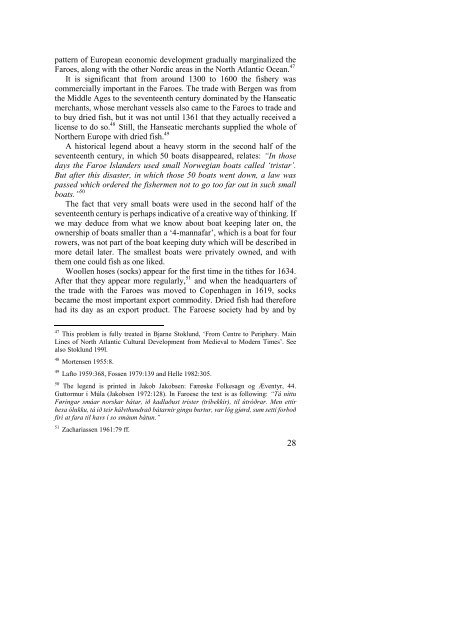The North Atlantic Fisheries, 1100-1976 - University of Hull
The North Atlantic Fisheries, 1100-1976 - University of Hull
The North Atlantic Fisheries, 1100-1976 - University of Hull
Create successful ePaper yourself
Turn your PDF publications into a flip-book with our unique Google optimized e-Paper software.
pattern <strong>of</strong> European economic development gradually marginalized the<br />
Faroes, along with the other Nordic areas in the <strong>North</strong> <strong>Atlantic</strong> Ocean. 47<br />
It is significant that from around 1300 to 1600 the fishery was<br />
commercially important in the Faroes. <strong>The</strong> trade with Bergen was from<br />
the Middle Ages to the seventeenth century dominated by the Hanseatic<br />
merchants, whose merchant vessels also came to the Faroes to trade and<br />
to buy dried fish, but it was not until 1361 that they actually received a<br />
license to do so. 48 Still, the Hanseatic merchants supplied the whole <strong>of</strong><br />
<strong>North</strong>ern Europe with dried fish. 49<br />
A historical legend about a heavy storm in the second half <strong>of</strong> the<br />
seventeenth century, in which 50 boats disappeared, relates: “In those<br />
days the Faroe Islanders used small Norwegian boats called ‘tristar’.<br />
But after this disaster, in which those 50 boats went down, a law was<br />
passed which ordered the fishermen not to go too far out in such small<br />
boats.” 50<br />
<strong>The</strong> fact that very small boats were used in the second half <strong>of</strong> the<br />
seventeenth century is perhaps indicative <strong>of</strong> a creative way <strong>of</strong> thinking. If<br />
we may deduce from what we know about boat keeping later on, the<br />
ownership <strong>of</strong> boats smaller than a ‘4-mannafar’, which is a boat for four<br />
rowers, was not part <strong>of</strong> the boat keeping duty which will be described in<br />
more detail later. <strong>The</strong> smallest boats were privately owned, and with<br />
them one could fish as one liked.<br />
Woollen hoses (socks) appear for the first time in the tithes for 1634.<br />
After that they appear more regularly, 51 and when the headquarters <strong>of</strong><br />
the trade with the Faroes was moved to Copenhagen in 1619, socks<br />
became the most important export commodity. Dried fish had therefore<br />
had its day as an export product. <strong>The</strong> Faroese society had by and by<br />
47 This problem is fully treated in Bjarne Stoklund, ‘From Centre to Periphery. Main<br />
Lines <strong>of</strong> <strong>North</strong> <strong>Atlantic</strong> Cultural Development from Medieval to Modern Times’. See<br />
also Stoklund 199l.<br />
48 Mortensen 1955:8.<br />
49 Lafto 1959:368, Fossen 1979:139 and Helle 1982:305.<br />
50 <strong>The</strong> legend is printed in Jakob Jakobsen: Færøske Folkesagn og Æventyr, 44.<br />
Guttormur í Múla (Jakobsen 1972:128). In Faroese the text is as following: “Tá níttu<br />
Føringar smáar norskar bátar, ið kadlaðust trister (tríbekkir), til útróðrar. Men ettir<br />
hesa ólukku, tá ið teir hálvthundrað bátarnir gingu burtur, var lóg gjørd, sum setti forboð<br />
firi at fara til havs í so smáum bátun.”<br />
51 Zachariassen 1961:79 ff.<br />
28















